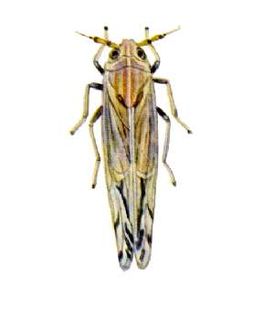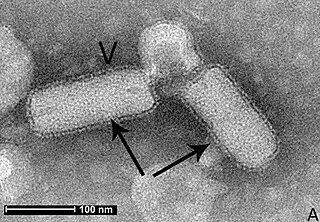
Potyvirus is a genus of viruses in the family Potyviridae. Plants serve as natural hosts. There are currently 183 species in this genus including the type species Potato virus Y. The genus is named after the type virus. Potyviruses account for ~30% of the currently known plant viruses. Like begomoviruses, members of this genus may cause significant losses in agricultural, pastoral, horticultural and ornamental crops. More than 200 species of aphids spread potyviruses and most are from the subfamily Aphidinae.
Tenuivirus is a plant virus genus belonging to Phenuiviridae family in the order Bunyavirales, of which the type member is Rice stripe tenuivirus. These plant viruses cause diseases in their host plants. Typical symptoms are chlorotic stripes on the affected leaves. This group of viruses also make viral inclusions in infected cells which can be used to diagnose infection.

Maize streak virus (MSV) is a virus primarily known for causing maize streak disease (MSD) in its major host, and which also infects over 80 wild and domesticated grasses. It is an insect-transmitted maize pathogen in the genus Mastrevirus of the family Geminiviridae that is endemic in sub-Saharan Africa and neighbouring Indian Ocean island territories such as Madagascar, Mauritius and La Reunion. The A-strain of MSV (MSV-A) causes sporadic maize streak disease epidemics throughout the maize growing regions of Africa. MSV was first described by the South African entomologist Claude Fuller who referred to it in a 1901 report as "mealie variegation".
Rice hoja blanca tenuivirus (RHBV), meaning "white leaf rice virus", is a plant virus in the family Phenuiviridae. RHBV causes Hoja blanca disease (HBD), which affects the leaves of the rice plant Oryza sativa, stunting the growth of the plant or killing it altogether. RHBV is carried by an insect vector, Tagosodes orizicolus, a type of planthopper. The virus is found in South America, Mexico, throughout Central America, the Caribbean region, and the southern United States. In South America, the disease is endemic to Colombia, Venezuela, Ecuador, Peru, Suriname, French Guiana and Guyana.
Barley stripe mosaic virus (BSMV), of genus Hordevirus, is an RNA viral plant pathogen whose main hosts are barley and wheat. The common symptoms for BSMV are yellow streaks or spots, mosaic, leaves and stunted growth. It is spread primarily through infected seed and can be spread through mechanical transfer of an infected and uninfected host. Plants infected with BSMV are more symptomatic in warmer temperatures. Resistant hosts and sterilization of equipment are the best ways to control the spread of the pathogen. BSMV has been known to reduce the yields of barley by up to 25%, but is not a major problem because of resistant varieties of barley.
Maize chlorotic dwarf virus (MCDV) is a plant pathogenic virus of the family Sequiviridae.
Maize Dwarf Mosaic Virus (MDMV) is a plant pathogenic virus of the family Potyviridae. Depending on the corn plant’s growth stage, the virus can have severe implications to the corn plant’s development which can also result in economic consequences to the producer of the crop.
Maize line virus is a pathogenic plant virus.
Maize mosaic virus (MMV) is a plant pathogenic virus of the family Rhabdoviridae.
Maize rough dwarf virus (MRDV) is a plant pathogenic virus of the family Reoviridae.
Maize white line mosaic virus (MWLMV) is a pathogenic plant virus.
Sugarcane Mosaic Virus (SCMV) is a plant pathogenic virus of the family Potyviridae. The virus was first noticed in Puerto Rico in 1916 and spread rapidly throughout the southern United States in the early 1920s. SCMV is of great concern because of the high economic impact it has on sugarcane and maize.
Rice stripe tenuivirus is an RNA plant pathogen of the genus Tenuivirus. It is prevalent in Japan, China, and Korea and can infect plants of the family Poaceae, which include wheat and corn. Damage from this disease causes major reductions in rice crop yield every year.

Benyvirus is a genus of viruses, in the family Benyviridae. Plant serve as natural hosts. There are currently four species in this genus including the type species Beet necrotic yellow vein virus. Diseases associated with this genus include: BNYVV: rhizomania.

Peregrinus maidis, known as the corn planthopper, is a species of insect in the order Hemiptera and the family Delphacidae. It is widespread throughout most tropical and subtropical regions on earth, including southern North America, South America, Africa, Australia, Southeast Asia and China. P. maidis are a commercially important pest of maize and its relatives. In addition to physical plant damage, P. maidis is the vector for several species-specific maize viruses, including maize stripe virus, maize mosaic virus and the non-pathogenic Peregrinus maidis reovirus.
High Plains wheat mosaic emaravirus (WMoV), or High Plains virus (HPV) or Maize red stripe virus (MRSV/MRStV) is the causative agent of High plains disease of maize and wheat. It is spread by wheat curl mite, Aceria tosichella, which also transmits Wheat streak mosaic virus. The mite's ability to transmit a number of different viruses to cereal crops make it an economically important agricultural pest. In late June 2017 this virus was first detected in Canada, in Alberta. The Alberta samples were 99% similar to those in the USA. As Wheat streak mosaic virus is already present in Alberta, and coinfection with these two causes even more severe damage, this could cause much higher yield losses.
Maize lethal necrosis disease is a viral disease affecting maize (corn) predominantly in East Africa, Southeast Asia and South America, which was recognised in 2010. It is caused by simultaneous infection with two viruses, maize chlorotic mottle virus (MCMoV) of the Tombusviridae family and a virus from the Potyviridae group: maize dwarf mosaic virus (MDMV), wheat streak mosaic virus (WSMV), sugarcane mosaic virus (SCMV), Johnsongrass mosaic virus (JGMV) or others.
Aureusvirus is a genus of viruses, in the family Tombusviridae. Plants serve as natural hosts. There are currently five species in this genus including the type species Pothos latent virus.

Cytorhabdovirus is a genus of viruses in the family Rhabdoviridae, order Mononegavirales. Plants serve as natural hosts.
Waikavirus is a genus of viruses in the order Picornavirales, in the family Secoviridae. Plants, poaceae, cyperaceae, and gramineae serve as natural hosts. There are currently four species in this genus including the type species Rice tungro spherical virus. Diseases associated with this genus include: MCDV: plant stunting and chlorotic striping of tertiary leaf veins in maize.




